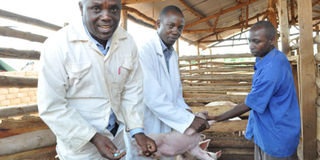The deadly disease every pig farmer should watch out for

A veterinary doctor (L) vacinates pigs on a farm. Pigs must be treated regulary to avoid deaths. PHOTO BY RACHEL MABALA.
Pig rearing remains a lucrative business, but it is often disrupted by diseases. One of the diseases that attack pigs is the African swine fever.
Characteristics
The disease is characterised by loss of appetite; the skin under the ears, snout, legs and abdomen becomes dark blue, and the animals vomit and cough.
The pigs may further bleed from the nose and rectum, have difficulties in breathing and they will have diarrhoea. In short, African swine fever is the most deadly pig disease.
Contagious
The viral disease is highly contagious and affects domesticated and wild pigs and warthogs.
It is transmitted mainly through direct contact with already infected pigs, their body fluids or their droppings, indirectly by ingestion of infected feedstuff especially garbage and by ticks that are vectors of the causing virus.
Sadly, African swine fever has no treatment and can wipe out an entire pig farm.
No vaccines have been developed but several bio-security measures can be practised to minimise its spread.
Remedy
“Watch out for biting flies, ticks, and limit the number of vehicles and people visiting your farm since they are other possible carriers of the disease,” says Felix Opinya and agronomist.
In fact to be safe farmers are encouraged to provide cover clothing material for visitors and ensure equipment used in your farm is clean.
“Make sure your visitors disinfect their shoes while vehicles run through a disinfectant. If possible, fence your pig farm to keep away wild animals like warthogs, forest hogs and domestic pigs and their ticks,” says Opinya.
Housing
Pig farmers further need to ensure proper housing structure, stocking density and feeding to curb the disease.
Also, be on the lookout for outbreaks since clinical signs can always be seen. In other circumstances, it may be severe, described by high fever and sudden deaths.
African swine fever has 100 per cent mortality rate and diagnosis is made from clinical signs and collecting samples of spleen and blood for laboratory analysis.
This is because in the body of susceptible animals, the virus dominantly concentrates in the blood and minor areas like meat, bones and skin.
Besides the bio-security measures, slaughter and dispose pigs infected with the disease and report cases for action by various veterinary bodies.
Caution
If the veterinary officer confirms the disease from laboratory diagnosis, the area of the outbreak should be quarantined to enclose the causative agent and to prevent spread. Thereafter, if your farm is infected, disinfect your premises thoroughly and do not re-populate for about two weeks.
Piggeries should have good drainage systems coupled with high standards of hygiene to help minimise disease attacks. Parasites being a major problem in the pig industry, farmers should control internal parasites like worms and external parasites like mites and lice, which stagger production levels.
Important to note
Currently, the best way of dealing with the disease outbreak is to fully destock by destroying all the pigs. All combustible materials contaminated by the pigs should be burned or deeply buried. Currently, the disease has no vaccine or treatment. It is only prevented by high levels of hygiene and sourcing of pigs from confirmed disease-free herds.




